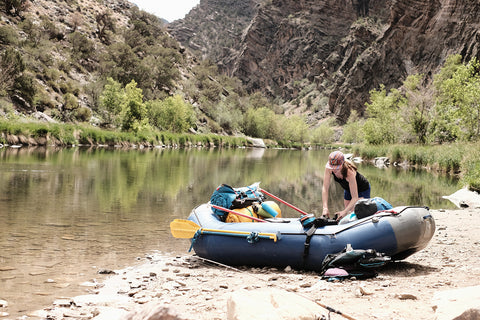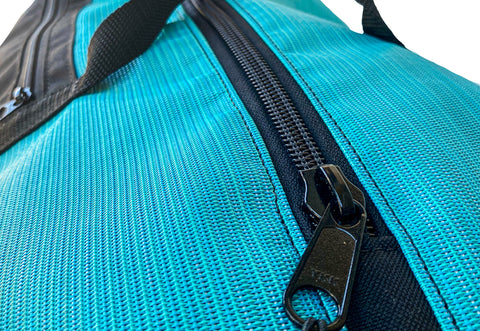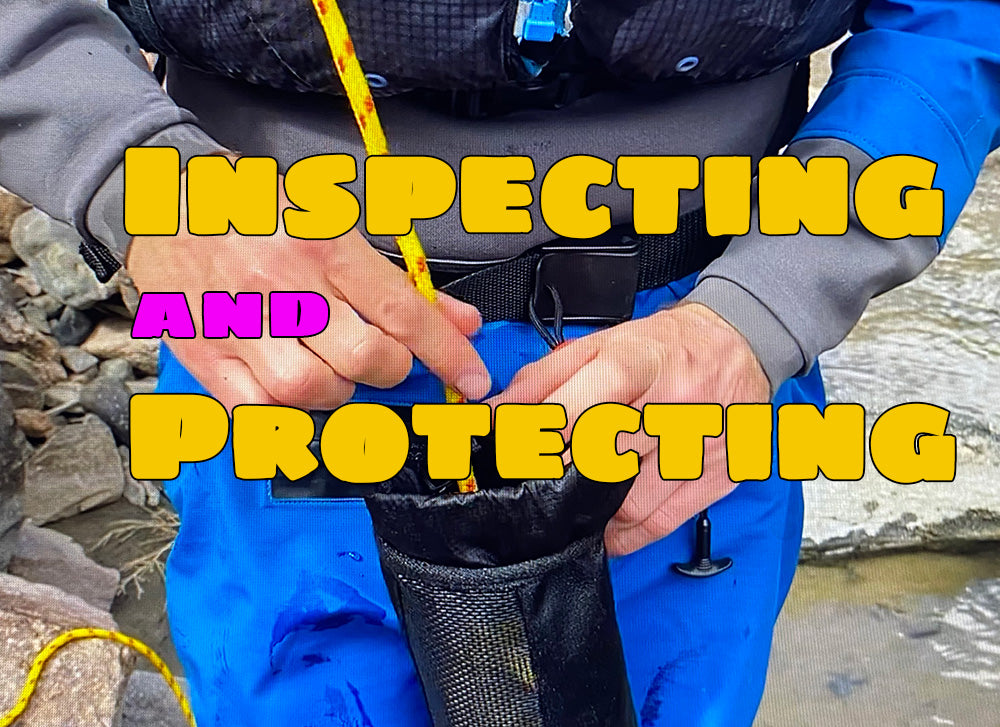Introduction
We spend our hard earned money on mountains of outdoor gear. Keeping your gear inspected and protected is a great way to prolong the life of your gear and keep it looking fresh. In this post we will be giving you some great tips on how to care for and inspect your gear. Taking good care of your gear will save you money in the long run. Who doesn’t love saving money!
Damaging UV Protection
Being out in the sun is great for whitewater rafting but it also comes at a price. The Sun is the most harmful element to your outdoor gear. UV rays deteriorate fabrics, threads, and fade colors fairly quickly. Polyester is a great fabric to choose from for whitewater gear because it holds up in the sun longer than other materials. Choose outdoor gear companies that use UV protected polyester thread in their sewing process. This will ensure you are getting your money’s worth out of all of that expensive gear. Keeping your smaller gear like throw bags, life jackets and helmets inside of a UV protective mesh gear bag during transportation and storage is a great way to keep those sun rays off of your gear. This will also keep the color dye in your gear from fading too quickly and keep you looking fresh for longer. I mean we do want to look good out there right? While we are on the subject of UV protection, I will also throw in a few lines about the importance of sunscreen. Your whitewater gear is replaceable, you are not. Wearing long, hooded sun shirts, and sunscreen will keep your skin protected from harmful UV rays also. Stripping down and getting some sun is okay now and then, but when you're on the river 7 days a week all summer, it's best to keep yourself covered as much as possible.

Safety Inspections
There are some dangers of using throw bags and especially waist throw bags if used improperly or if a piece of gear fails because of wear. We will give you some tips on what to look for generally with products and a few specific things to check with River Station Gear products. Generally with throw bags you want to make sure the top buckle and cinch cord are in good shape and working properly. You don’t want your rope to unknowingly come out and get into a moving river. Another thing to check is the tie-in knot. Make sure it is still a nice looking, well dressed knot. Lastly, make sure your rope itself is in good shape. You’ll want to make sure there are no deep knicks in the sheath and your core is well protected. On waist throw bags, the most important thing to check additionally, is the quick release buckle and tie-ball. It is essential to be able to release the waist throw bag off of your body quickly in the event of getting it caught on something. Make sure the knot on the tie-ball is tied tightly and is dressed well. Make sure the paracord itself is in good shape and the core is protected. With River Stations Rapid Pack you will want to make sure the cinch cord and barrel cord lock are in good shape. With fast throw bags like this, there isn’t a huge line of protection from your rope being able to come out. So always insure your cord lock is cinched with ALL of your rope contained within the throw bag. If you don’t like inspecting gear or don’t feel comfortable with fast throw bags, there are many options out there that are very safe!
Keeping Gear Dry
Mold and mildew aren’t just stinky. It’s a living growing organism that can stain and/or damage your fabrics and thread. Keeping your river gear dry is important and like anything takes a bit of getting into a good habit. When you get off the river, get your gear out in the sun and breeze for a few minutes to dry before throwing it into a dry bag and forgetting about it for a month. A clothes line is a good option as long as you don’t leave it out there for a week! (Remember the damaging UV rays.) Personally I do a quick dry on the clothes line for a few and then get all of my gear round up and into my mesh gear bag. A mesh gear bag is a great tool to keep your gear dry and protected. It’s breathable, so if things are still a little damp, it will still ultimately dry out. Keeping your gear not only protected but also keeping you from being a stinky guide!

Retire, Repair or Replace
Like everything on earth, gear will inevitably wear out at some point. Knowing when it’s time to call it can be tricky sometimes. We get attached to our favorite gear and don’t want to get rid of it even if it's completely worn and falling apart. But it’s part of life, retiring your old gear doesn’t have to be sad. Know that you are doing the right thing and keeping yourself safe. Plus, now you get to go shopping for new gear! What’s better than buying new river gear? If you have a piece of defective gear or accidentally broke something maybe look into having it professionally repaired or exchanged. Usually if you reach out to the company who sold you gear, they will be glad to help you find a solution to getting your gear repaired or replaced.
Maintaining Zippers
There are lots of cases where someone has tossed a bag because of a zipper malfunction. Usually a zipper can be fixed quite easily and won’t need to be fixed in the first place if it is properly cared for. Keeping sand and debris out of the zipper teeth is a good start. You can wash zippers with mild soap and warm water followed by a good rinse. Once clean, let it dry and apply zipper lubrication. Zipper lube keeps the zipper functioning smoothly and will greatly increase its life, especially on large drysuit zippers. If a zipper is no longer zipping the teeth together it can usually be pressed and tightened to get some more life out of it. If you have damaged or missing zipper teeth, unfortunately it is time to retire or replace your gear.

Preemptive Care
How long your gear will last mostly comes down to you. If you chuck your gear into the yard and let it bake in the sun for weeks, you can’t expect that your gear will last very long. On the other hand, if you preemptively take care of and frequently inspect your gear, it can last a very long time. Not only saving you money, but potentially saving a life, or at least keeping you safer. If you have questions about gear care, don’t be afraid to reach out and shoot the company an email, they will very likely want to help you and could give you some good information.
By : Jason Caligaris Jr.


Share:
7 Tips for Throw Bagging
You’re Invited to a River Costume Party